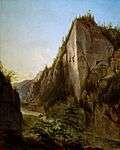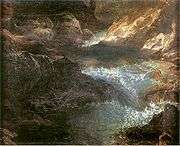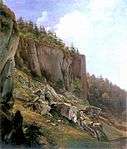Jan Nepomucen Głowacki
Jan Nepomucen Głowacki (1802 – July 28, 1847) was a Polish realist painter of the Romantic era, regarded as the most outstanding landscape painter of the early 19th century in Poland under the foreign partitions.[1][2] Głowacki studied painting at the Kraków School of Fine Arts and later at the academies of Prague and Vienna, as well as Rome and Munich. He returned to Kraków in 1828, and became a teacher of painting and drawing. From 1842 he served as a professor in the Faculty of Landscape Painting at the School of Fine Arts. His work can be found at the National Museum of Poland and its branches.[3] Some of his work was looted by Nazi Germany in World War II and has never been recovered.[4]
Jan Nepomucen Głowacki | |
|---|---|
.jpg) Oil on canvas, 1842 (unnamed) | |
| Born | 1802 Kraków, Poland |
| Died | July 28, 1847 (aged 44–45) Kraków, Poland |
| Nationality | Polish |
| Education |
|
| Known for | Painting, art history |
| Movement | Realism |
Work
Głowacki was born in Kraków, where he lived for most of his life. He took his first art lessons with the painter Antoni Giziński, and between 1819 and 1825 attended the workshops of Józef Brodowski and Józef Peszka at the School of Fine Arts in Kraków. He continued his studies in Prague and then at the Academy of Fine Arts in Vienna under Franz Steinfeld until 1828. He went to Rome in 1834/35 and finished his studies in Munich. While abroad, he went by the name Jean Nepomuk Glowacki.[5] Upon his return from Vienna, Głowacki became a teacher of art in his hometown and also a prolific artist. He painted mostly landscapes and city scapes, as well as portraits, and religious or mythological scenes.[1] He was influenced by the Viennese school of realism, which was especially apparent in his portrait studies. Polish art critics and historians consider him the father of Polish school of landscape painting.[6]
Głowacki was the first Polish artist to devote an entire series of works to the Tatra Mountains.[6] He was also the first, to produce studies for his oil paintings on strenuous outdoor trips. Landscapes such as "Widok z Poronina" (View from Poronin, 1836) and "Morskie Oko" (1837) are said to mark the beginning of realist Polish mountain painting.[7] His Romantic city scapes of Kraków and its environs became very popular during his lifetime thanks to an album of 24 prints that he published in 1836.[5] He was married and had a son, Justyn Jan Głowacki, born in 1838, and a daughter Emilia (ca 1840). Very little else is known about his personal life.[8]
Notes and references
- "Jan Nepomucen Głowacki, Kraków 1802 - Kraków 1847". Spis malarzy (in Polish). Pinakoteka Zascianek.pl. Retrieved August 22, 2012.
- Antoni Nowak, transl. by Matthew Dundon. "Closing statements" (PDF direct download, 100 KB). The Oldest Images of the Tatras. Euroregion Tatry EU. Retrieved August 22, 2012.
- "Jan Nepomucen Głowacki". Malarstwo polskie XIX wieku. Katalog zbiorów Muzeum Narodowego w Krakowie (in Polish). Muzeum Narodowe w Krakowie. 2001. Archived from the original on May 11, 2015. Retrieved August 22, 2012.
- Monika Kuhnke. "Lost art: Jan Nepomucen Glowacki (sample)". Wartime Losses - Polish Painting - Catalogue. Retrieved August 23, 2012.
Index of known artwork looted in World War II.
- Grove Art, Oxford Art Online (2003). "Jan Nepomucen Glowacki short biography". Artfact Auctions. Retrieved August 22, 2012.
- "Jan Nepomucen Głowacki". Lista obiektów autora (in Polish and English). Muzeum Narodowe w Krakowie. 2010. Retrieved August 22, 2012.
- Stanisław Eljasz-Radzikowski. "Głowacki Jan Nepomucen". Pierwszy artysta-malarz polski w Tatrach, Wielka Encyklopedia Tatrzańska. Zakopianski Portal Internetowy. Retrieved August 22, 2012.
- "Justyn Jan Nepomcen Głowacki". Wielka Genealogia Minakowskiego (in Polish). Wielcy.pl. May 3, 2011. Retrieved August 22, 2012.
![]()



